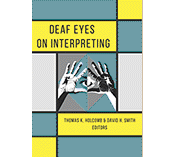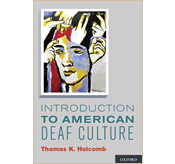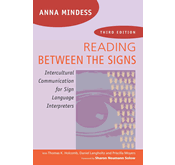Anna:
I recently returned from a trip to Kyoto and Osaka Japan, where I had food adventures like this lesson from a sushi fanatic. Also with the help of connections, I got the chance to meet and chat with some deaf people in Japan. Since JSL is very different from ASL, it was lucky for me that many Japanese deaf people are motivated to study ASL because they enjoy traveling and socializing with foreigners. I got invited to visit a few classes in Kyoto and Osaka.
Natsuko and Maru co-teach an ASL classes at night (while teaching JSL by day). Coincidentally, they had met Tom six months ago when they visited Ohlone College to observe teaching methods. Their students were excited to have me visit and asked me to spend the first part of the class introducing myself and my work. They seemed especially interested when I told them that I work mostly in the courtroom doing legal interpreting. The situation in Japan is not what deaf people enjoy in the U.S. So there is not yet legal training offered to JSL interpreters. I stressed the importance of having interpreters with legal training and also told them that working with CDIs (Certified Deaf Interpreters) is often the most effective approach in court. I suggested that if they are in a position to set up interpreting protocols for court, that they begin by having deaf interpreters be part of the process, instead of trying to add them in later, as is the case here.
After that discussion, Natsuko told the class to break up into two teams to play a game. I thought I would just sit and observe, but it turned out that the object of this guessing game was to make ME guess the answers. Each team turned over pictures that Natsuko had prepared and had 2 minutes to huddle and decide on 3 ASL signs to convey the subject of the picture to me. (Of course they were not allowed to use a sign for the name of the object). The first round, the signs they gave me were JAPAN, FAMOUS and HIGH. Hmmm…it took me a minute. I couldn’t think of a Japanese counterpart to the iconic Eiffel Tower or Leaning Tower of Pisa. Finally, I had a thought. “Is it Mount Fuji?” I asked, doubtfully. The team exploded with cheers and high 5’s. Another round produced: JAPAN SPORT FAT. “Sumo wrestling!” I answered confidently. Again, high 5’s and cheers. I had a blast because I love games and I realized this one was also a test of my knowledge of Japanese Culture. After the game, with a close score of 4 to 5, we all went out to an izakaya to drink and eat!
Another evening, I met Danny Gong, an American CODA who now lives in Japan and teaches ASL with DEAF JAPAN . He also makes cute videos, like this one comparing the ASL and JSL signs for SUMMER. Culturally speaking, it makes total sense that the JSL sign looks like a waving fan. (Boy, was it hot there the last few weeks too!)
I also was invited to present a lecture at Kansai Gaidai University for a class called Deaf World Japan, taught by Professor Steven Federowicz who has a blog called Visual Anthropology of Japan. His students are mostly American foreign exchange students, but also a few from other countries. Another day, I came back to his class to see a deaf woman, Ms. Morimoto, present. She told the story of her life with the challenge of dealing with an oral education, trying to learn to speak and lip-read Japanese, the physical punishments students endured at school when they were caught signing and her delight in using JSL.
It seems that there are divisions in the Deaf communities in Japan, some pushing for Signed Japanese, while others advocating for JSL. To demonstrate the difference to these beginning learners of JSL, Ms. Morimoto did a clever demonstration. She first showed the generic sign for EAT in JSL, in which one hand “holds the bowl” and the other uses two fingers to represent the action of bringing chopsticks from the bowl to the mouth.
Then she held up drawings of other specific foods and asked students to show how they would eat a SANDWICH, OKINOMIYAKI (a large vegetable pancake that one slices one piece at a time), SUSHI or TAKOYAKI (a snack of grilled octopus made into a ball that is speared with a toothpick to eat.) Of course, in JSL, EATING each of these foods would require a different sign, as the action required does not resemble bringing rice to the mouth with chopsticks. But, said Ms. Morimoto, Signed Japanese would use the generic sign for EAT + the noun form of each of these foods. I thought this was a great example and also tied back into my fascination with Japanese food.









